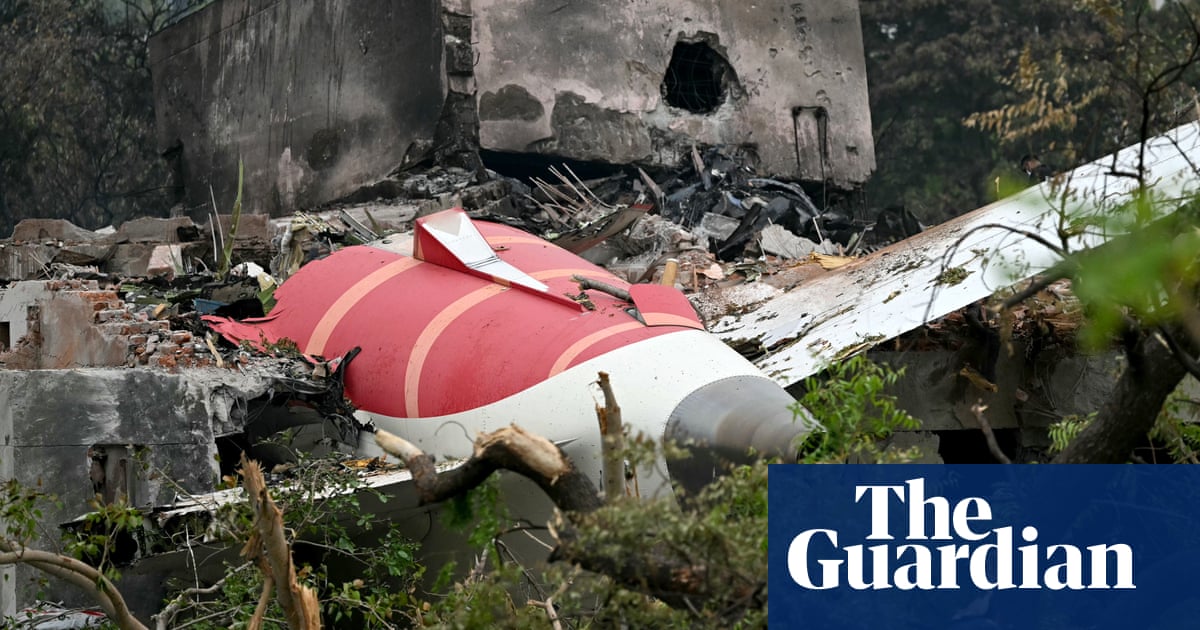A full investigation into AirIndiaflight AI171 will be necessary to determine what caused it to crash shortly after taking off from Ahmedabad but aviation experts say a range of potential factors could have been at play.
Air India 171 – a Boeing 787-8, also known as a Dreamliner – issued a mayday call to air traffic control moments after takeoff. According to the Flightradar24 website, its tracking signal was lost when the plane had reached 625ft (190 metres).
Footage has emerged appearing to show the plane take off, rise slowly with its nose up, then begin to descend seconds later, gliding downwards before crashing into a building and exploding into a ball of fire.
The sole survivor out of the 242 people onboard, 40-year-old Vishwash Kumar Ramesh, hassaid he has “no idea” how he livedto walk out of the wreckage.
Aviation experts cautioned against jumping to conclusions less than 24 hours after the crash, insisting only a thorough investigation including examination of the black box and flight data recorder would give a definitive picture.
However, aviation analysts have put forward a range of theories as to what led to the tragedy, in what is the first such fatal incident involving the Dreamliner.
Dr Sonya Brown, a senior lecturer in aerospace design at the University of New South Wales, said the footage suggested the plane had stalled. “It does look to me like a significant loss of thrust. Thrust effectively makes you go faster, and aircraft lift is proportional to speed squared, so if you don’t have thrust and you lose speed – and radar data suggests after the initial short climb it was losing speed – you can stall,” Brown said.
What caused the lack of thrust remained unclear, Brown said.
Some interpreted video footage as showing the wing flaps were not extended during takeoff, with suggestions this could have been a pilot error and factor in the crash. These panels on the wings of a plane can be extended to help generate lift and are key during takeoff and landing.
Brown said she was unsure of the flap status after watching the footage, and that even if reviewing the black box and flight data recorders showed flaps were not deployed, a stall could still be avoided with increased thrust.
Brown said incorrect thrust settings due to human error could be one cause. She also noted that while the plane was modern, it was 11 years old, so the potential for inadequate maintenance could be investigated.
Neil Hansford, a former pilot and chair of the Strategic Aviation Solutions consultancy, said that while pilot error could have been a factor, the crew and airline were respected.
“The captain and first officer were very experienced. This is a superior plane, we’re not talking about a cowboy airline here,” Hansford said.
Bird strikes, a common occurrence in aviation where wildlife interferes with a plane’s engine, is one early theory, with engine failure plausibly leading the plane to stall.
The Boeing 787 is a two-engine plane but is able to fly on one engine, one of many layers of redundancy baked into modern aviation that has made it one of the statistically safest forms of transport.
While it is rare for a bird strike to take out two engines simultaneously, it can happen. Bird strikes took outboth engines of US Airways flight 1549 in 2009, forcing the captain, Sully Sullenberger, into a landing on New York’s Hudson river.
Hansford noted a history of hundreds of bird strikes at Ahmedabad airport, and that there were warm temperatures on Thursday morning – conditions that make bird strikes more likely.
Ramesh, the sole survivor, told the Hindustan Times that “30 seconds after takeoff there was a loud noise”. Hansford said a loud bang could occur when birds entered an engine and caused it to fail, but he believed if both engines failed, there would have been two loud bangs.
Brown, as well as Dr Jason Knight, a senior lecturer in fluid mechanics at the University of Portsmouth, also said bird strikes could be responsible.
Knight said: “The most likely cause of the crash is a double engine failure. Because the altitude was so low, the pilot would have had very little time to do an emergency landing. The most likely cause of a double engine failure is a bird strike, which would take out the engine.”
While extremely rare, when plane crashes did happen, takeoff and landing were when it was most likely something could go wrong, said Hansford.
Prof John McDermid, the Lloyd’s Register chair of safety at University of York, said: “Pilots can abort takeoff until quite late in the takeoff roll, so it seems like the problem occurred very suddenly in the final part of the takeoff roll, or shortly after takeoff, and was sufficiently serious to be unmanageable.”
The many layers of redundancy, such as backup power sources and computer monitoring systems such as autopilot, and, when all else fails, the ability for a plane to glide – which was seen briefly on Thursday before impact – may have been less helpful in helping the pilots to avoid crashing due to the lack of altitude.
Brown said: “All of these things are more effective if you have time, but this happened so soon after takeoff. If you had the same issue at 40,000ft, it’s very different to 400ft. There’s just not many layers of redundancy at that altitude.”
Hansford believed other theories the investigators should examine were potential sabotage, noting political tensions in Gujarat state, of which Ahmedabad is the capital.
Contaminated fuel was another possibility, he said. The plane’s fuel tank was reportedly near-full, but Hansford said contaminants could lead to clogging. “Blocking fuel could cause an engine problem,” he said.
